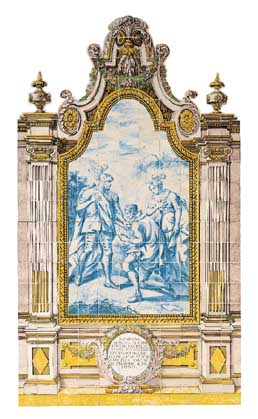|
|
|
|
|
|
|
|
|
|
|
|
 |
|
|
|
|
|
|
|
 |
|
|
|
|
|
|
The XVIII · XIX Centuries
The Neoclassicism
|
 hanks largely to the work of the Real Fábrica de Louça in the Rato area of Lisbon, at the end of the XVIII century Portuguese tiling assimilated the influence of Neoclassicism, an international style disseminated by the engravings of Robert and James Adam. In Portugal this innovation was associated on tiles with landscapes painted by Jean Pillement. hanks largely to the work of the Real Fábrica de Louça in the Rato area of Lisbon, at the end of the XVIII century Portuguese tiling assimilated the influence of Neoclassicism, an international style disseminated by the engravings of Robert and James Adam. In Portugal this innovation was associated on tiles with landscapes painted by Jean Pillement.
Ceramic panels now took the form of low ashlars and were co-ordinated with fresco painting. The tiles recall the fresco style with its unadorned, white, painted backgrounds, taking on a lightness and a profuse variety of themes and compositions which made this type of combination one of the most surprising ever achieved.
The panels were covered with light embellishments in refined polychrome tones and with very little volume. Their centres were pinpointed with monochrome calligraphic medallions and they matched the taste of the new bourgeoisie, which also began to order large quantities of tiles.
This new class of customer chose panels which told the story of their social successes and represented elegant figures of the period, while the Church remained faithful to its traditional religious cycles and the aristocracy to the themes it had always preferred.
|
|
|
|
|
Pombal Mansion,
Lisbon, c. 1800.
photograph: Carlos Monteiro (DDF-IPM)
|
|
|
|
|
|
 |
|
|
|
|
|
|
 |
|
|
|
|
|
Historical panel,
José Berardo Foundation, Funchal, c. 1805.
photograph: Carlos Monteiro DDF/IPM
|
|
|
|
|
|
|
|
|
|
|
|
|
|
São Julião Church,
Mafra, 1807 · 1808.
photograph: Carlos Monteiro DDF/IPM
|
|
|
|
|
|
|
© Instituto Camões, 2000
|
|
|
|